
This unit describes the endocrine system.
- Subject:
- Health and Physical Education
- Material Type:
- Lecture
- Provider:
- Open Michigan
- Author:
- Oregon Health & Science University
- Date Added:
- 09/15/2021


This unit describes the endocrine system.
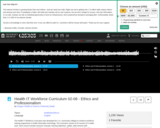
This unit describes the traditions and values that guide physicians, nurses, and allied health professionals. It explores medical ethics, professionalism and legal duties and applies ethics and professionalism to specific topics, including health informatics.
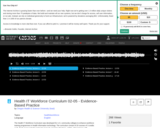
This unit describes the application of evidence-based medicine (EBM). The discussion begins with the framing of clinical questions that can be answered by appropriate evidence. It then demonstrates how to find and apply the best evidence for answering four major types of clinical questions: interventions, diagnosis, harm, and prognosis. The unit also introduces summarizing of evidence (systematic reviews) as well as clinical practice guidelines and concludes with a discussion of the limitations of EBM.

This lesson provides simple activities for younger children to explore balance. Students will demonstrate spatial awareness and the ability to follow instructions. They will experience different movement forms.
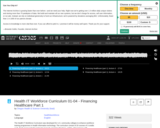
This introductory unit covers definitions of terms used in the component, with an emphasis on paradigm shifts in healthcare, including the transition from physician-centric to patient-centric care, the transition from individual care to interdisciplinary team-based care, and the central role of technology in healthcare delivery. This unit also emphasizes the core values in US healthcare.
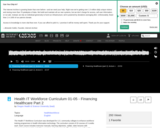
This unit continues the discussion of healthcare financing at the governmental, organizational, and consumer levels. It describes the revenue cycle for healthcare organizations, identifies the different reimbursement methodologies and standards developed for the billing (reimbursement) process. Finally, this unit reviews some of the factors responsible for the escalating healthcare expenditures in the US and discusses some methods for controlling rising medical costs.
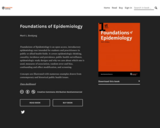
This book is intended to provide a basic introduction to epidemiologic methods and epidemiologic thinking. After reading this book, you should be able to read an epidemiologic study, understand what the authors did and why, and identify what they found. You will also have the tools to assess the quality of that study—how good is the evidence? What are potential sources of bias, and how might those have affected the results? This book will not teach you enough to be able to design and conduct your own epidemiologic studies—that level of understanding requires several years of specialized training. However, being able to read and understand the scientific literature about human health will allow you to apply that understanding to your own work in a nuanced, sophisticated way.

Build class routines with fun and engaging activities designed to reinforce 3 simple classroom rules.
1) Respect Self; 2) Respect Others; 3) Respect the Things We Use
Build on these simple rules to create a safe environment where students are empowered to explore physical activity and movement while building meaningful relationships with trusting adults and supportive peers.
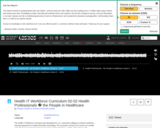
This unit discusses the health professionals who deliver healthcare and the training needed to work in these professions. The following professionals are described in this unit: physicians, nurses, advanced practice nurses, physician assistants, pharmacists, therapists, allied health professionals, paramedics, EMTs, dental professionals, mental health professionals, and social workers.

This unit describes the process used by a clinician to make a diagnosis and determine a care plan. This includes gathering information from the patient as well as other objective and subjective sources, managing and organizing the information, comparing the information to known states of disease, and developing a care plan for the patient.
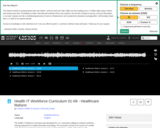
This unit provides an overview of healthcare trends including evidence based medicine, quality and practice-care recommendations, comparative effectiveness research, and an overview of healthcare reform initiatives in the US.
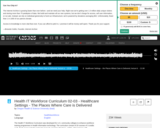
This unit describes healthcare delivery sites including outpatient care, hospitals, tertiary care centers, academic medical centers, the VA healthcare system, the military health system, the Indian health service, and non-traditional delivery sites such as school-based, community-based, and employer-based sites. It also specifically examines the structure, function and interrelationship between healthcare settings.

In this video segment adapted from NOVA, follow novice runners as they train for a marathon, and discover how quickly the body responds to regular aerobic exercise.
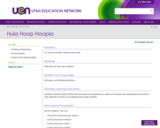
This lesson includes various activities using the hula hoop.

This is a module framework. It can be viewed online or downloaded as a zip file.
As taught Autumn semester 2009.
Infections are a major cause of morbidity and mortality worldwide. The body fights infection through the functions of the immune system, whose power has been harnessed by the development of vaccination (immunisation).
Suitable for study at: Undergraduate levels 1 and 2.
Dr Ian Todd, School of Molecular Medical Sciences.
Dr Ian Todd is Associate Professor & Reader in Cellular Immunopathology at The University of Nottingham. After reading Biochemistry at The University of Oxford, he carried out research for his PhD in Immunology at University College London. He then undertook post-doctoral research at The Oregon Health Sciences University and The Middlesex Hospital Medical School. His main research interest is in the molecular and cellular bases of autoimmune and autoinflammatory diseases. He is a Fellow of the Higher Education Academy and a recipient of the Lord Dearing Award for Teaching & Learning.
Important Copyright Information:
All images, tables and figures in this resource were reproduced from 'Lecture Notes Immunology' April 2010, 6th Edition, published by Wiley-Blackwell and with full permission of the co-author and faculty member, Dr Ian Todd.
No image, table or figure in this resource can be reproduced without prior permission from publishers Wiley-Blackwell.
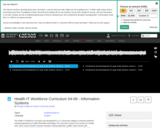
This unit defines information systems and describes how they are used. It discusses how an information system is designed, developed, tested, supported and maintained. Finally, it explains how information systems are used in healthcare settings, including the role of specialized information systems.
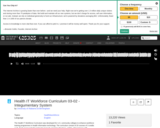
This unit describes the integumentary system.
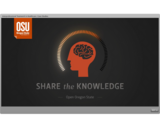
Students will be able to describe specific team-based actions and skills that empower healthcare providers to deliver participatory, patient/client-centered care
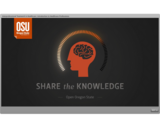
Students will be able to describe the scope of practice, roles, and unique contributions of various health care professions.
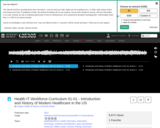
This introductory unit covers definitions of terms used in the component, with an emphasis on paradigm shifts in healthcare, including the transition from physician-centric to patient-centric care, the transition from individual care to interdisciplinary team-based care, and the central role of technology in healthcare delivery. This unit also emphasizes the core values in US healthcare.